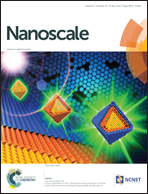Metal contact effect on the performance and scaling behavior of carbon nanotube thin film transistors†
Abstract
Metal–tube contact is known to play an important role in carbon nanotube field-effect transistors (CNT-FETs) which are fabricated on individual CNTs. Less attention has been paid to the contact effect in network type carbon nanotube thin film transistors (CNT-TFTs). In this study, we demonstrate that contact plays an even more important role in CNT-TFTs than in CNT-FETs. Although the Schottky barrier height at the metal–tube contact can be tuned by the work function of the metal, similar to the case in CNT-FETs, the contact resistance (Rc) forms a much higher proportion of the total resistance in CNT-TFTs. Interestingly, the contact resistivity was found to increase with channel length, which is a consequence of the percolating nature of the transport in CNT films, and this behavior does not exist in CNT-FETs and normal 2D Ohmic conductors. Electrical transport in CNT-TFTs has been predicted to scale with channel length by stick percolation theory. However, the scaling behavior is also impacted, or even covered up by the effect of Rc. Once the contact effect is excluded, the covered scaling behavior can be revealed correctly. A possible way of reducing Rc in CNT-TFTs was proposed. We believe the findings in this paper will strengthen our understanding of CNT-TFTs, and even accelerate the commercialization of CNT-TFT technology.


 Please wait while we load your content...
Please wait while we load your content...